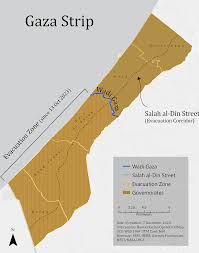lets see Latest Developments in Gaza strip 2025: What’s Happening and What’s Next? The Gaza Strip is one of the most contested regions in the world, frequently making headlines due to its complex political and humanitarian issues. With key figures like Benjamin Netanyahu, and Donald Trump, and organizations such as Hamas playing crucial roles, understanding the Gaza is essential. This blog post explores its history, ownership disputes, geopolitical significance, and the latest developments in 2025.

Who Owns the Gaza Strip?
The ownership of the Gaza Strip is a long-debated issue. Historically, it has been controlled by various rulers:
- Before 1948: Part of Mandatory Palestine under British rule.
- 1948–1967: Controlled by Egypt following the Arab-Israeli War.
- 1967: Captured by Israel during the Six-Day War.
- 2005: Israel unilaterally withdrew, but still controls airspace, borders, and sea access.
- 2007–Present: Hamas has de facto control, following a violent split from the Palestinian Authority.
Despite Israel’s withdrawal, it still maintains a blockade over Gaza, restricting movement and trade. The situation remains volatile due to periodic clashes between Hamas militants and the Israeli military.
What is the Gaza Strip?
The Gaza Strip is a 141-square-mile coastal enclave located between Israel, Egypt, and the Mediterranean Sea. It is densely populated, with over 2 million Palestinians, many of whom are refugees from earlier wars. The region is often called the “Riviera of the Middle East”, but this contrasts with the dire humanitarian conditions on the ground.
Gaza has a semi-arid climate, with limited natural resources, which has led to severe economic struggles. The economy relies heavily on foreign aid, agriculture, fishing, and a limited manufacturing sector. Due to Israeli restrictions, many goods and services remain scarce.
When Did Gaza Become a Conflict Zone?

The conflict dates back decades:
- 1948: The creation of Israel led to the first Arab-Israeli War, with Palestinians displaced.
- 1967: Israel captured Gaza in the Six-Day War.
- 2005: Israel withdrew but kept economic control.
- 2007: Hamas took over, leading to Israeli blockades and periodic wars.
- 2014 & 2021: Major conflicts occurred, with international intervention.
- 2025: Tensions continue, with negotiations and confrontations ongoing.
Where is the Gaza Strip?
The Gaza Strip is located on the eastern Mediterranean coast, bordered by Israel to the north and east and Egypt to the south. It serves as a crucial geopolitical point between the Middle East and North Africa.
Why is Gaza So Important?
Gaza’s significance stems from:
- Geopolitical Importance: A strategic link between the Middle East and Africa.
- Religious Ties: It holds significance in Jewish, Christian, and Islamic histories.
- Political Power Struggles: It’s central to the Israel-Palestine conflict.
- Security Concerns: Frequent military clashes with Israel.
- Humanitarian Crisis: High population density and economic restrictions lead to suffering.
Additionally, the region has been a key flashpoint in U.S.-Israel relations, with policies shifting under different administrations. Donald Trump’s recognition of Jerusalem as Israel’s capital in 2017 further intensified tensions, impacting U.S.-Palestine relations.
How Does the World View Gaza?
International views on Gaza vary:
- United Nations: Calls for a two-state solution.
- United States: Historically supports Israel, though recent U.S. presidents, including Donald Trump, have shifted policies.
- European Union: Supports Palestinian rights but condemns Hamas.
- Arab Nations: Mixed responses, with Egypt maintaining border controls.
- The Atlantic & Jerusalem Post: Media outlets covering the conflict from different perspectives.
Latest Developments in 2025
As of 2025, several key events shape Gaza’s landscape:
- Israel-Gaza Relations: Continued blockades and skirmishes.
- Trump’s Influence: Donald Trump, despite no longer being president, remains vocal on Gaza issues.
- Netanyahu’s Government: Policies continue to impact Palestinian territories.
- Palestinian Resistance: Ongoing protests and diplomatic efforts.
- Hamas vs. Fatah Tensions: Internal Palestinian divisions persist.
Top 20 FAQs About the Gaza Strip
- Where is the Gaza Strip located?
In the eastern Mediterranean, bordered by Israel and Egypt. - Who controls the Gaza Strip?
Hamas has de facto control, while Israel controls airspace and borders. - What is the population of Gaza?
Around 2 million people. - Why is Gaza important geopolitically?
It serves as a critical link between the Middle East and Africa. - What was Donald Trump’s stance on Gaza?
He supported Israel’s policies and moved the U.S. embassy to Jerusalem. - Who was Benjamin Netanyahu?
Israel’s Prime Minister, is known for his hardline policies. - What role does Egypt play in Gaza?
Egypt controls the Rafah border crossing. - What is Hamas?
A Palestinian militant and political organization governing Gaza. - Is there ethnic cleansing in Gaza?
The term is debated, but many international organizations cite human rights violations. - What is the humanitarian situation in Gaza?
Severe poverty, food shortages, and lack of medical supplies. - Why does Israel control Gaza’s borders?
For security reasons, citing Hamas’s attacks. - What is the Gaza Strip map like?
A narrow strip along the Mediterranean with high population density. - Who are the Palestinians?
An ethnic group native to the region. - What is the Jerusalem Post’s stance on Gaza?
It generally supports Israel’s policies. - What is the impact of the Gaza conflict on world news?
It remains a central issue in international diplomacy. - How does the U.S. view Gaza?
Varies by administration; typically supports Israel. - What is the Riviera of the Middle East?
A term sometimes used for Gaza, though it contrasts with its realities. - Did Trump and Netanyahu discuss Gaza?
Yes, frequently, especially during their press conferences. - What is the future of Gaza?
Uncertain, with ongoing negotiations and conflicts. - How does the world view the Israel-Gaza conflict?
It remains one of the most divisive issues in global politics.
DeepSeek AI R1: China’s New AI Contender Reshaping Global Technology
